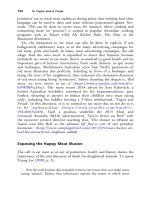The palgrave international handbook of a 507
Bạn đang xem bản rút gọn của tài liệu. Xem và tải ngay bản đầy đủ của tài liệu tại đây (38.09 KB, 1 trang )
510
M. Gupta et al.
structural equation modeling to illustrate potentially different pathways to
violence against animals for males and females.
It follows that just as there is no single “cure” for interpersonal violence,
there is unlikely to be one uniform approach to intervention that works for
everyone who has harmed animals. If a heterogeneous group of offenders
receives a single intervention, even if that intervention works very well for
some, its positive effect is likely to be difficult to detect amidst the outcome
data from the whole group. Yet while programs such as AniCare emphasize
using the results of individualized assessment to inform intervention strategy,
such toolkit-style, non-manualized approaches lend themselves less readily to
outcome evaluation. Considerable work is needed to further clarify potential
subtypes of animal abuse offenders who may warrant differing intervention
approaches, and to develop distinct intervention approaches that work
optimally for each. However, this work requires access to large populations
of offenders in research-oriented intervention settings, which (as discussed as
part of the “referral pipeline problem”) is not currently the norm.
A controversial but related question is whether all animal abuse offenders
actually need intervention. Public opinion suggests that they do: Bailey et al.,
(2016) assessed undergraduate students’ reactions to reading animal cruelty
vignettes in which the species of animal victim, age of perpetrator, and location
of crime (that is, in kennel or shelter) varied. Across all vignettes, the median
response was “Strongly Agree” to the item, “The guilty person should have to
complete psychological counseling or complete an anger management program.” At the same time, participants also strongly agreed that all offenders
should receive punishment. Psychosocial interventions remain unpopular with
some prosecutors who see them as antithetical to offender accountability and
punishment, or as minimizing the seriousness of crime. In our view, this
argument perpetuates a false dichotomy between intervention and punishment, illustrated satirically in the song “Gee, Officer Krupke” from the classic
musical West Side Story (Sondheim 1957): e.g., “This boy don’t need a job, he
needs a year in the pen”; “The trouble is he’s crazy/The trouble is he drinks/
The trouble is he’s lazy/The trouble is he stinks.”
However, it is still important to ask—through a lens informed by data
rather than opinion—whether there is a subset of animal abuse offenders for
whom it may not be possible to develop effective intervention, and for whom
punishment or other approaches may consequently be more effective.
Although the current state of research knowledge may not yet permit
answering this question definitively, it should remain on the table. The
presence of significant numbers of “incurable” offenders in outcome research
is likely to have the same result as providing an intervention that is









